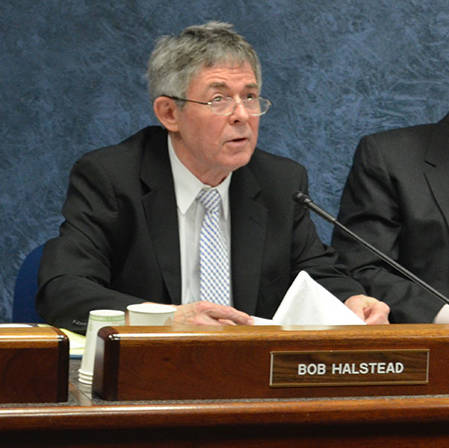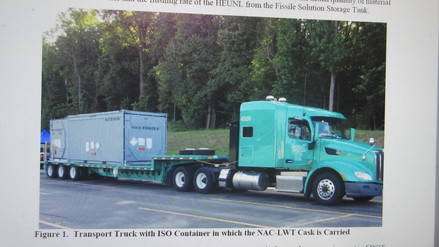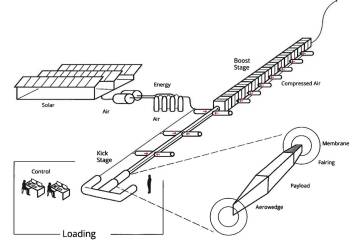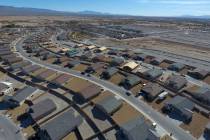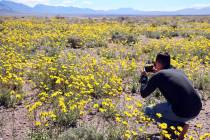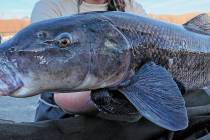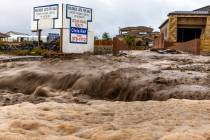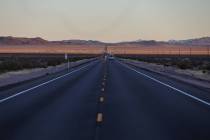‘Hot spot’ in nuclear waste shipment underscores Yucca Mountain concern
A radioactive “hot spot” discovered in a nuclear waste shipment in South Carolina is being cited by Nevada’s top nuclear safety official as fresh evidence of the folly of plans to transport thousands of tons of even-more-dangerous material to Yucca Mountain if a repository is built there.
The incident in April, first publicized this week by anti-nuclear groups, involved highly enriched uranium liquid waste trucked from Canada to the U.S. Department of Energy’s Savannah River Site near Aiken, South Carolina. The “hot spot” — an area of unexpectedly high radiation levels — was blamed on a defective, lead “pig” container that shields workers when waste is moved from inside transportation casks.
The Department of Energy said that when the “pig” was positioned for emptying at the Savannah site, radiation rates were slightly higher than expected but did not pose an increased safety concern to the public or workers.
But Bob Halstead, executive director of Nevada’s Agency for Nuclear Projects and the state’s point man in the battle to block the Yucca Mountain nuclear waste repository, said the incident illustrates the risks of shipping potentially deadly radioactive waste by rail or truck.
‘Great care’ required
“The radiological characteristics of this material are of lesser concern than spent fuel or high-level waste (envisioned for the Yucca Mountain repository),” he said. “Nonetheless this material requires great care in transportation. … We would also be concerned about any kind of incident that indicates a weakness in the safety culture.”
A spokeswoman for the U.S. Defense Nuclear Facilities Science Board said there was no risk to the public from the hot spot incident and no workers received a “higher dose than expected” when the first of some 100 truck shipments of liquid uranium waste from Canada arrived in mid-April at the Savannah site.
Energy Department officials who responded to an inquiry from the Las Review-Journal on condition they not be identified or quoted directly said that because the hot spot was limited to the pig, and not an exterior shipping cask, the incident was not considered a problem with the transportation process. The defective pig was taken out of service, they said in an email.
The officials stressed that the liquid waste would never have made its way into the proposed Yucca Mountain repository, 100 miles northwest of Las Vegas.
Instead of being converted into glass logs for disposal at a permanent repository, as is envisioned for other liquid waste at the Savannah River Site and the DOE’s Hanford Site in southeastern Washington, the Canadian waste will blended with natural uranium and be shipped to the Tennessee Valley Authority for commercial power reactor fuel, they said.
The hot-spot problem was first noted in an April 21 Defense Nuclear Facilities Safety Board inspection report.
Radiological protection personnel “identified an unexpected hotspot on the side of the pig indicating (it) was not providing adequate radiological shielding,” reads a memo from inspectors to the board’s technical director.
Canada paying U.S. to take waste
Anti-nuclear groups say Canada is paying $60 million to the U.S. government for the Savannah River Site to take 6,000 gallons of liquid waste from medical isotope production in Chalk River, Ontario.
The Department of Energy, citing security reasons, doesn’t release the amounts of radioactive waste being shipped, transportation routes or schedules.
But anti-nuclear watchdog organizations, including Beyond Nuclear and Savannah River Site Watch, believe the transport truck carrying the shipment entered the U.S. by crossing Peace Bridge in Buffalo, New York, and arrived in South Carolina sometime between April 16 and April 21.
Word of the incident came amid efforts in Washington to revive the proposal to permanently entomb at least 77,000 tons of high-level nuclear waste within Yucca Mountain in Nye County. President Donald Trump has proposed $120 million for licensing the waste facility and to create a robust interim storage program for fiscal year 2018, which begins Oct. 1.
The House Energy and Commerce Committee also is writing legislation that would revive the project, which was mothballed in 2012 by former President Barack Obama.
U.S. Sen. Dean Heller, R-Nev., took to the floor of the Senate on May 18 to warn his colleagues that he intends to oppose all efforts to send the dangerous waste piling up at reactor sites across 44 states to Nevada via highways and railroads.
“I am standing between this administration and Yucca. And I say to my colleagues on both sides of the aisle that I will lead the fight,” he said. “This is a reckless proposal. Over the past 30 years, the federal government has wasted billions of taxpayer dollars to design and permit Yucca Mountain — all without any signal that Nevada would consent to it.”
Contact Keith Rogers at krogers@reviewjournal.com or 702-383-0308. Find him on Twitter: @KeithRogers2


